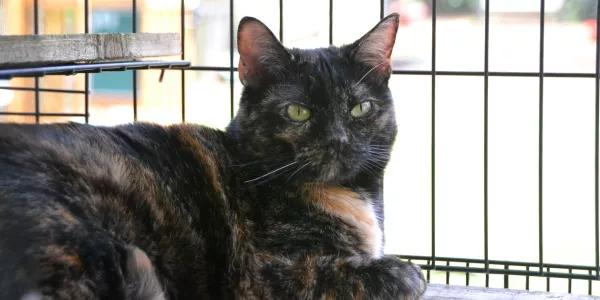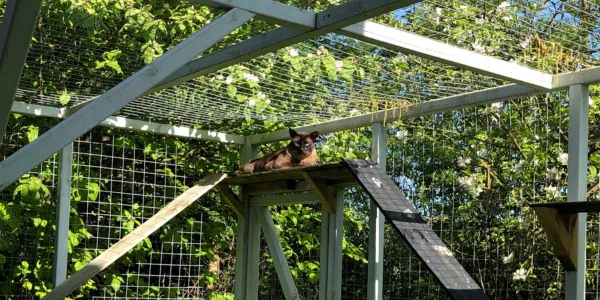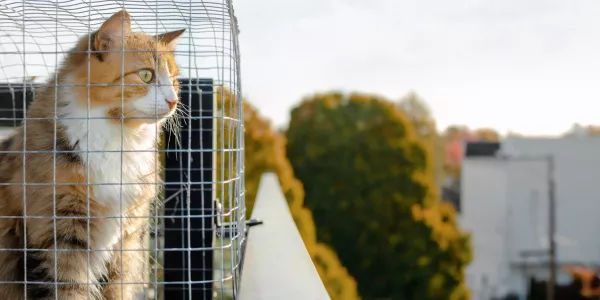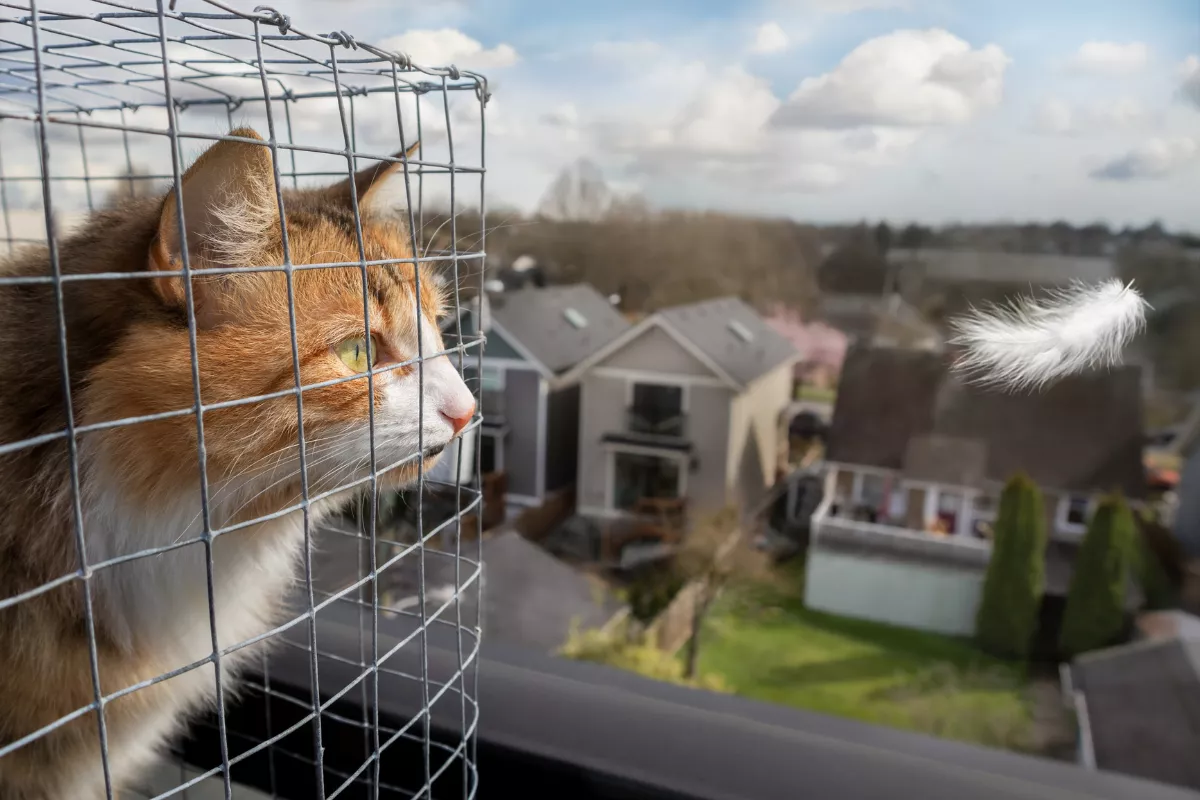Did you hear about "catios" and get curious? Catios are a trending topic among cat lovers and pet owners. There are patios for humans and catio for cats - it's as simple as that! And they offer benefits all around: they're great for pet owners looking to provide ample outdoor time for their cats, and they allow cats to safely satisfy their curiosity while protected from potential predators.
If you're wondering what a catio is, whether it's more economical to buy or build one, the costs involved, and the pros and cons, you're in the right place. We are here to answer all of your questions about catios!
What is a Catio?
A catio, short for "cat patio," is an outdoor enclosure that allows your feline friend to enjoy the outdoors safely. These structures range from small, window-attached units to large, freestanding structures in a yard. Catios provide a secure environment where cats can play, relax, and watch the world from the safety of an enclosed space.
Catios are available in a variety of designs and dimensions, ranging from basic wire-mesh enclosures to complex, multi-tiered play areas. They can be self-made, assembled from a kit, or professionally crafted by expert catio builders.
Types of catios
Catios come in various types to suit different spaces, needs, and preferences. Finding one that will perfectly suit your space and attend to your cat’s level of activity and curiosity won’t be a hard task. Here, we’ve selected some to exemplify your options:
Window box catios

It offers a compact and convenient solution for cat owners who want to provide their feline companions with a taste of the outdoors without the need for a large yard. These small enclosures attach directly to a window, creating a secure, elevated space where cats can bask in the sunlight, enjoy fresh air, and observe the outside world.
Ideal for apartments or homes with limited outdoor space, window box catios are a simple yet effective way to enrich your cat's environment, allowing them to indulge their natural curiosity and instinct to watch from a safe vantage point.
Freestanding catios

They are versatile outdoor enclosures that provide cats with a spacious and stimulating environment, independent of the structure of the house. These catios can be placed anywhere in a garden or yard, offering multiple levels and features such as climbing shelves, perches, and ramps for cats to explore.
They are particularly suitable for homeowners who have more outdoor space and wish to give their cats a substantial area to roam, play, and relax in the safety of an enclosed outdoor area.
Attached catios

Seamlessly extending from a house or apartment, attached catios offer a secure and accessible outdoor haven for cats. These structures are typically connected to a door or window, blending the comfort of the indoor space with the excitement of the outdoors.
Designed to provide a safe enclosure where cats can enjoy fresh air, sunbathe, and watch the world from a protected vantage point, attached catios vary in size and complexity, from simple screened areas to elaborate extensions with multiple levels and play features.
The impacts of catios on wildlife
Catios have a significant positive impact on wildlife, particularly in urban and suburban areas. Here's how:
Reduction in Predation
Cats are natural predators and can significantly impact bird populations and other small wildlife. By keeping cats contained in catios, there's a drastic reduction in their hunting activities, which helps protect local wildlife.
Wildlife Conservation
In areas with endangered or vulnerable species, catios help mitigate the risk of cats preying on these critical populations. This is particularly important for preserving biodiversity and maintaining ecological balance.
Less Disruption to Wildlife Habitats
Cats often disrupt wildlife habitats, not just through predation but also through their presence, which can stress wildlife. Catios prevent these disruptions, allowing for more natural and less stressed wildlife behaviors.
Reduction in Disease Transmission
Cats can transmit diseases to wildlife, and vice versa. By limiting direct contact, catios help reduce the spread of diseases like toxoplasmosis, which can have serious impacts on wildlife health.
Encouraging Responsible Pet Ownership
The concept of catios promotes awareness among pet owners about the impact their pets can have on local ecosystems. This awareness can lead to more responsible behaviors that benefit wildlife.
Is It Cheaper to Buy or Build a Catio?
The expense of constructing a catio can significantly fluctuate based on various elements, such as the catio's dimensions, the types of materials utilized, and whether you opt for professional assembly or a do-it-yourself approach.
For a modest, self-made catio using basic elements like wood and chicken wire, costs can start from approximately $100-$300. In contrast, more elaborate and larger catios can escalate to a few thousand dollars or higher, particularly if you engage a professional builder for the job.
Other factors that might influence the catio's cost include:
Geographical Location
In regions with higher living costs, the price for materials and labor needed for a catio build can be pricier.
Quality of Materials
Opting for higher-end materials like sturdy woods or metal meshes will cost more when compared to more basic options.
Additional Features
Incorporating extras such as a roof, integrated shelves, and ramps can add to the catio’s overall expense.
Given the broad spectrum of available designs and materials, pinpointing an average cost for building a catio can be challenging. It’s advisable to explore various designs and price points before finalizing your catio plan.
Should I buy or build a catio?
Deciding whether to buy or build a catio depends on your skill level. If you're handy with tools, building a catio can be a rewarding DIY project. Otherwise, purchasing a pre-made unit might be the way to go. Here are a few considerations when buying or building your catio:
Customization
Building your own allows for customizing the size, shape, and features to fit your space and your cat's needs. Pre-made catios come in standard sizes and designs.
Cost
While buying a pre-made catio can be more expensive upfront, building one requires purchasing materials, tools, and potentially, plans. Don't forget to factor in your time and labor if you choose to build one.
What are the downsides of a Catio?
For renters and certain homeowners, a catio might not be feasible or could be too costly, and it's not a convenient choice for those who frequently move or travel. Additionally, interactions with stray cats can be a source of stress for your pet.
Even if direct contact is not possible, strays can still come close enough to spray, transmit diseases and parasites, or otherwise negatively impact your cat's well-being. There's also the risk of exposure to fleas, ticks, and mosquitoes, although this can be managed with continuous flea, tick, and heartworm prevention treatments for your cat.
People also ask
How do I keep my catio clean?
Keeping your catio clean involves regular maintenance to ensure a healthy and hygienic environment for your cat. Start by removing any waste or litter daily and wiping down surfaces with a pet-safe disinfectant. It’s important to clean and refresh water and food dishes regularly.
Additionally, wash any bedding or cushions used in the catio to prevent flea infestations and remove hair buildup. For the structure itself, inspect and clean the wire mesh and frames periodically to remove dirt, cobwebs, and leaves. Implementing these simple, routine cleaning steps will help maintain a pleasant and safe outdoor space for your feline friend.
Can a catio be used in all weather conditions?
A catio can be used in various weather conditions, but its usability depends on its design and the local climate. In moderate weather, catios provide a great outdoor space for cats. However, in extreme weather conditions like heavy rain, snow, or intense heat, they might not be suitable without proper modifications.
To enhance a catio for all-weather use, consider adding features like waterproof roofing, windbreaks, insulation for cold weather, and shaded areas for hot days. Ensure the catio is well-ventilated yet protected from harsh elements. During severe weather, it's safest to keep your cat indoors. Regularly check and maintain the catio to ensure it remains a safe, comfortable environment for your cat regardless of the weather.
Do I need a permit to build a catio?
This depends on local regulations. Regulations for planning differ across jurisdictions, yet in several cases, catios require official approval. If they exceed 8 feet in height, are located in the front yard, or occupy half of the garden space, it's recommended to consult with the local planning department.

 Marcio Vasconcelos
Marcio Vasconcelos





